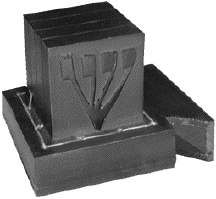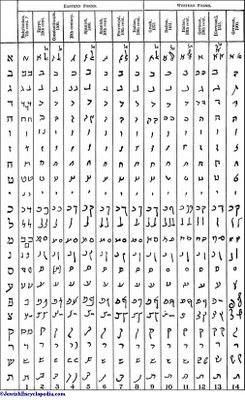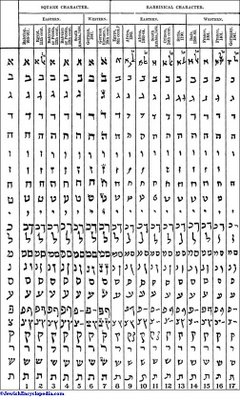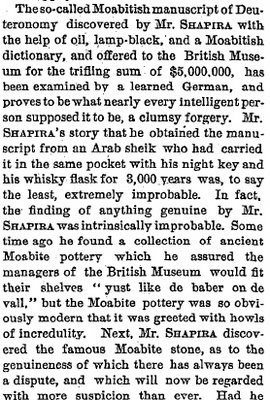I came across an interesting article by James A. Montgomery, scholar of Samaritanism, called Notes From the Samaritan Journal of Biblical Literature, Vol. 25, No. 1 (1906) , pp. 49-54. The article concerns a witness to a 19th century Samaritan pronunciation of the tetragrammaton.
At the outset, Montgomery mentions that 5th century Church theologian Theodoret preserved in writing a Samaritan pronunciation of the tetragrammaton. It was as follows: Iota-alpha-beta-epsilon (edit: evidently I can't use Greek characters in blogger) or Iota-alpha-beta-alpha-iota (Yabe or Yabai). Of course the usual caveats about transliterating Hebrew into Greek apply (Greek doesn't share the same consonants, so many of them are simply ignored--like the ה in this case-- or transposed into what the transcriber considers to be the closest match). What is interesting is that the ו is written with a beta, which would mean that to Theodoret's ears the ו was pronounced as a consonant and probably like how we pronounced the letter v and not w.
Montgomery then notes that Samaritans actually tended not to pronounce the tetragrammaton at all, like Jews, but rather they substituted the word shema (in the sense of שם, the Name, just as we say השם, Hashem). This fact is readily confirmed by perusing articles on the web site by and about the Samaritans.
It seems that in the early 1800s French scholars who were carrying on a correspondence with Samaritans were trying to get them to tell them how the word was pronounced, which they were reluctant to do. But in a letter to Silvestre de Sacy one of them spilled the secret: he wrote in vocalized Arabic characters something like Ya'-ha'-waw-ha' (again, can't do Arabic, apparently) which is Yahwa or Yahwe in English. De Sacy himself apparently didn't notice the potential signifigance of this--he hadn't been asking anything about the pronunciation.
It was later noticed, and compared by scholars with Samaritan rhyming hymns. To one scholar, Emil Kautzsch, these rhymes suggested that the final consonant was Yahwe, rather then Yahwa. (It is interesting to note that Kautzsch cited the rhymes found in R. Wolf Heidenheim's Bibliotheca Samaritana. R. Heidenheim is the one Grade A maskil who is cited as a source in Artscroll's Stone Chumash). Other scholars pointed out that other rhymes favored the other pronunciation, with an a at the end. So no conclusion could be drawn, especially since in the popular Samaritan pronunciation the consonants of the tetragrammaton would be read shema, which means that the rhymes probably were meant for that word.
In other words תיקו.
It must further be remembered that the signifigance of a Samaritan pronunciation for any Hebrew word is complicated for a number of reasons. One is that their Hebrew pronunciation was also affected by the ravages of time, movement and the influence of Arabic. Secondly, we know that the Samaritan Hebrew is defective in many respects. They lost the guttural letters far earlier than other Jews, for example. Third, it is still unclear how ancient the pronunciation of the tetragrammaton is. As noted, Samaritans don't really say it. Did this one incidental witness preserve an actual ancient pronunciation? Who knows?
Finally, a great anecdote retold by a contemporary Samaritan leader, Benyamim* Tsedaka, on exactly this question, how Samaritans pronounce י-ה-ו-ה:
At the outset, Montgomery mentions that 5th century Church theologian Theodoret preserved in writing a Samaritan pronunciation of the tetragrammaton. It was as follows: Iota-alpha-beta-epsilon (edit: evidently I can't use Greek characters in blogger) or Iota-alpha-beta-alpha-iota (Yabe or Yabai). Of course the usual caveats about transliterating Hebrew into Greek apply (Greek doesn't share the same consonants, so many of them are simply ignored--like the ה in this case-- or transposed into what the transcriber considers to be the closest match). What is interesting is that the ו is written with a beta, which would mean that to Theodoret's ears the ו was pronounced as a consonant and probably like how we pronounced the letter v and not w.
Montgomery then notes that Samaritans actually tended not to pronounce the tetragrammaton at all, like Jews, but rather they substituted the word shema (in the sense of שם, the Name, just as we say השם, Hashem). This fact is readily confirmed by perusing articles on the web site by and about the Samaritans.
It seems that in the early 1800s French scholars who were carrying on a correspondence with Samaritans were trying to get them to tell them how the word was pronounced, which they were reluctant to do. But in a letter to Silvestre de Sacy one of them spilled the secret: he wrote in vocalized Arabic characters something like Ya'-ha'-waw-ha' (again, can't do Arabic, apparently) which is Yahwa or Yahwe in English. De Sacy himself apparently didn't notice the potential signifigance of this--he hadn't been asking anything about the pronunciation.
It was later noticed, and compared by scholars with Samaritan rhyming hymns. To one scholar, Emil Kautzsch, these rhymes suggested that the final consonant was Yahwe, rather then Yahwa. (It is interesting to note that Kautzsch cited the rhymes found in R. Wolf Heidenheim's Bibliotheca Samaritana. R. Heidenheim is the one Grade A maskil who is cited as a source in Artscroll's Stone Chumash). Other scholars pointed out that other rhymes favored the other pronunciation, with an a at the end. So no conclusion could be drawn, especially since in the popular Samaritan pronunciation the consonants of the tetragrammaton would be read shema, which means that the rhymes probably were meant for that word.
In other words תיקו.
It must further be remembered that the signifigance of a Samaritan pronunciation for any Hebrew word is complicated for a number of reasons. One is that their Hebrew pronunciation was also affected by the ravages of time, movement and the influence of Arabic. Secondly, we know that the Samaritan Hebrew is defective in many respects. They lost the guttural letters far earlier than other Jews, for example. Third, it is still unclear how ancient the pronunciation of the tetragrammaton is. As noted, Samaritans don't really say it. Did this one incidental witness preserve an actual ancient pronunciation? Who knows?
Finally, a great anecdote retold by a contemporary Samaritan leader, Benyamim* Tsedaka, on exactly this question, how Samaritans pronounce י-ה-ו-ה:
I have to tell you a Samaritan folk tale on an argument between a Samaritan sage, my grandfater's father, Abraham Tsedaka [1852-1928] and a Moslem sage, The moslem said that the Islam is the right religion but Abraham Tsedaka has dared to say that the Israelite religion is the origional and true one and the Islam religion is a false one.*Not a typo. The Samaritan Torah consistently spells בנימים for בנימין.
How dare you say that? screamed the Moslem.
Abraham Tsedaka said that he is going to prove his words. He said: you know the last words of the moslem before he is passing away are to admit the unity of God by saying "La Illah Illa Alla"=No God but God - four words. The Israelite says the same but in his words: "Shema Eluwwinu Shema A'aad"= Our God one God - four words.
Yes, I know that, said the Moslem, so what?
Oh, let me tell you by that, said Abraham Tsedaka to the Moslem sage: If the Moslem soul is passing away before he expressed only one word "No", so it is negetive, and if he has expressed only two words " No God" it means that there is no God = heresy, and if he expressed only three words "No God But", nobody will know but whom, and it is also heresy. only if his soul will pass away after he has expressed the whole four words he will admit the unity of God.
At the same case each word the four words of the israelites has its significance for the unity of God - said Abraham Tsedaka - If the dying person has expressed only the first word: Shema, he has identified already the divinity, and if he has said only two words: Our God, it has a meaning. If he has said three words: Our God One, it is leading to the unity of God. He does not have to say the whole words to express it.
It is only a tale but saying much on the Samaritan acceptability of the unity of God of Israel.
Let me quote from the Samaritan Israelites' prayer, any prayer: "The glory is yours forever, Yoot-Eay-Baa-Eay, Shema, merciful and gracious....."























